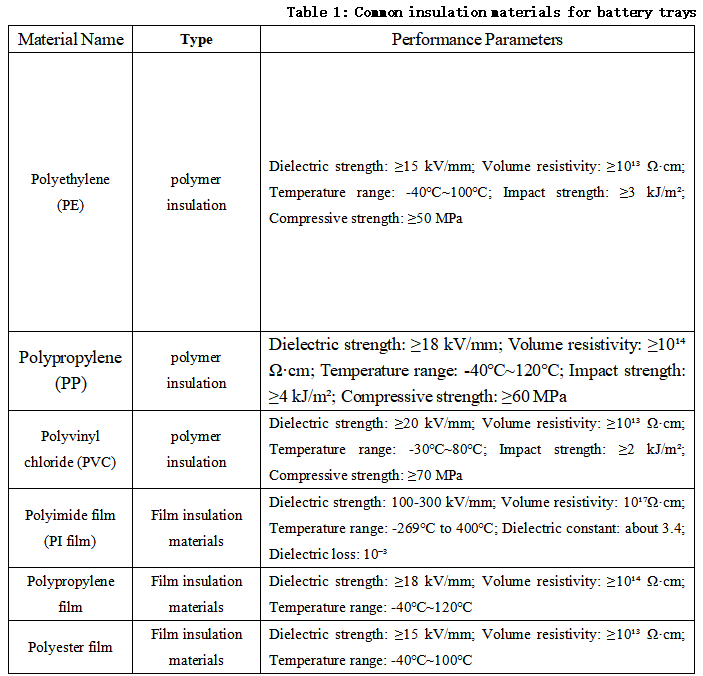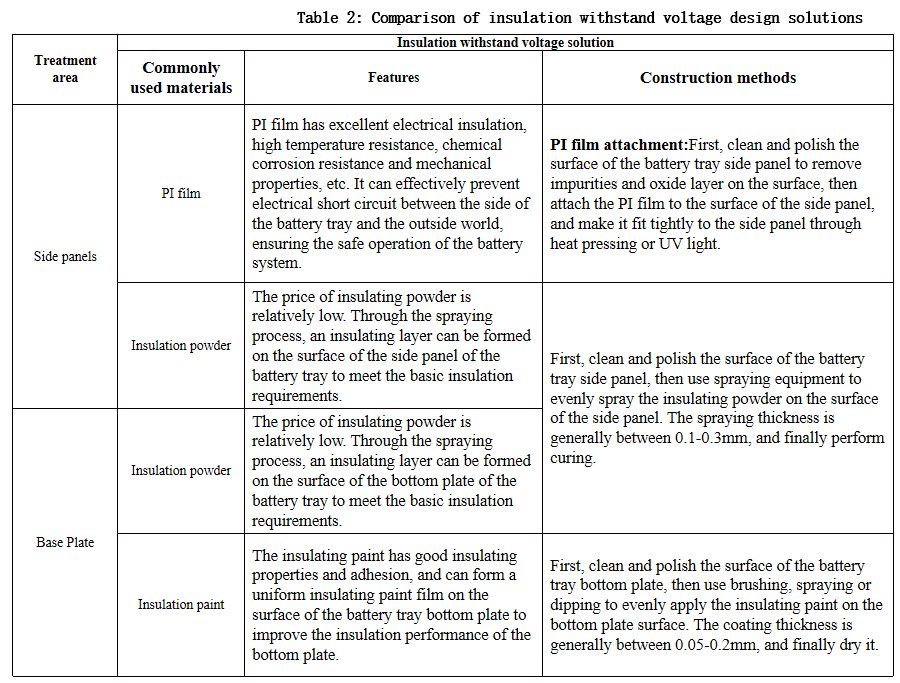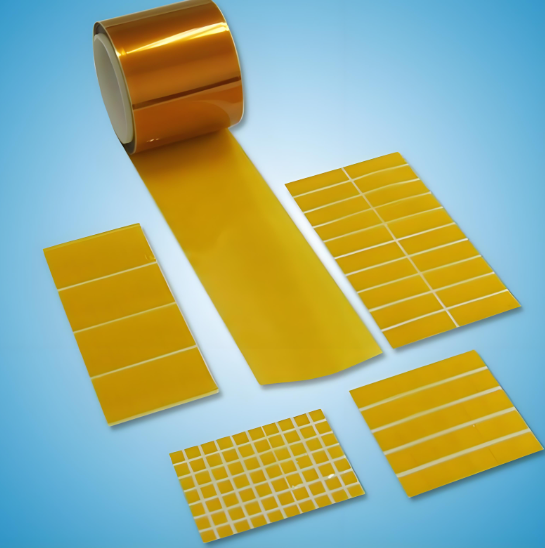
Communication and sharing promote growth
Joining Hands for Development!

The battery tray uses insulating materials mainly to prevent current leakage, protect personnel safety, and ensure the normal operation of the battery system. When selecting, it is necessary to consider the material's insulation properties, heat resistance, chemical stability and mechanical strength. These factors together determine the application effect of the insulation material in the battery tray, thus affecting the safety and reliability of the entire battery system.
Part 2 - Pressure resistance performance guarantee
Figure 1 Electric vehicle battery tray
1-Insulation material selection and solution design
In the selection of insulation materials for battery trays, the focus is on the dielectric properties, environmental tolerance and mechanical properties of the materials. The following are 6 commonly used insulation materials in battery trays and their related information:

When designing a solution, we generally need to comprehensively consider the three key factors of application scenario, performance requirements and cost budget to select the appropriate insulation material. For example:
(1) Select according to the application scenario: In a high-voltage, high-current energy storage battery system, if the battery tray side requires high-performance insulation material, it is recommended to use the PI film attachment solution; if the insulation performance requirements are not high, the insulation powder spraying solution can be selected. For the battery tray bottom plate, if a low-cost insulation solution is sought, the insulation powder spraying or insulation paint coating solution is more suitable.
(2) Select according to performance requirements: When the requirements for insulation performance, high temperature resistance, chemical corrosion resistance, etc. are high, the PI film attachment solution is a better choice; if these performance requirements are relatively low, the insulation powder spraying or insulation paint coating solution can meet the needs.
(3) Select according to the cost budget: When the cost budget is limited, the insulation powder spraying or insulation paint coating solution is more economical; when the cost budget is sufficient, the PI film attachment solution can be selected.

2-Technical requirements for PI film for battery trays
(1) Material: PI, base film thickness 0.1-0.14mm, back adhesive thickness 0.03mm, PI film thermal conductivity > 0.3W/(m·k);
(2) Pressure resistance: AC 3000V, 60S, leakage current ≤ 0.5mA;
(3) (cold paste) 180° peel strength ≥ 15N/24mm;
(4) Insulation: DC 1500V, 60S, insulation resistance > 1000MΩ;
(5) Heat and electrolyte resistance insulation performance: at 500℃, 700V DC voltage, add 2ml electrolyte (test area 13000mm<H>2<H>), keep for 1h, no breakdown and no sparking;
(6) Heat and insulation performance: at 500±2℃, continue baking (muffle furnace) for 0.5h, the overall morphology of the sample changes without spontaneous combustion, and the sample passes twice. AC 1000V is applied to the surface, and the voltage is increased from 0V to 3000 for 10S, and then continued for 60S. The tested sample has no breakdown and no sparking;
(7) Flame retardant grade: UL94 V-0;
(8) High temperature and high humidity: After 1000 hours of 85℃ and 85% humidity test, the sample has no cracking and no deformation, meeting the national standard "GBT 13542.6-2006 Electrical insulation film Part 6: Polyimide film for electrical insulation" on insulation resistance, withstand voltage value, and electrical strength requirements. The tensile strength, elongation at break, and peel strength are reduced by less than 30% compared with the unaged material;
(9) Hot and cold shock: 85℃ for one hour, switched to -40℃ for one hour, and then switched to 85℃ for high and low temperature cycles. The switching time is included in one hour, and the switching time is ≤3min. After 1000 hours of high and low temperature cycling, the sample has no cracking and deformation, meeting the national standard "GBT 13542.6-2006 Electrical insulation film Part 6: Polyimide film for electrical insulation" for insulation resistance, withstand voltage value, and electrical strength requirements. The tensile strength, elongation at break, and peel strength are reduced by less than 30% compared to the unaged material.
(10) Salt spray test: Neutral salt spray test (NSS) test in GB/T 10125 standard, temperature 35℃, humidity ≥85%RH, test solution is (5±0.1%) (mass fraction) NaCl, PH=6.5~7.2, continuous spraying for 72h. After the salt spray test, the sample has no cracking and no deformation, meeting the national standard "GBT 13542.6-2006 Electrical insulation film Part 6: Polyimide film for electrical insulation" for insulation resistance, withstand voltage value, and electrical strength requirements. The tensile strength, elongation at break, and peel strength are reduced by less than 30% compared with the unaged material.
(11) The product complies with RoHS.

Figure 2 PI film for battery tray
3-Insulation withstand voltage test methods and solutions to common problems
(1) Insulation withstand voltage test method
Insulation withstand voltage test is an important means to evaluate the insulation performance of electrical equipment, mainly including DC withstand voltage test and AC withstand voltage test. DC withstand voltage test detects whether the insulation material breaks down within a specified time by applying DC high voltage. The equipment includes DC high voltage generator, voltmeter, etc. The steps are applying voltage, maintaining voltage and reducing voltage. AC withstand voltage test applies AC high voltage. The equipment and steps are similar to DC test. Both methods require preparation before testing to ensure that the equipment is well grounded and the surface condition of the insulation material is closely observed during the test.
(2) Common problems and solutions
Common problems in insulation withstand voltage test include insulation breakdown, excessive leakage current and test equipment failure. Insulation breakdown may be caused by insufficient insulation material performance, internal defects or moisture. Solutions include selecting high-quality materials, strengthening maintenance and improving insulation structure. Excessive leakage current may be caused by reduced insulation resistance, surface contamination or insufficient accuracy of test equipment. Solutions include keeping the insulation material clean and dry and calibrating the test equipment. Test equipment failure may be caused by equipment aging, improper maintenance or improper operation. Solutions include regular maintenance, correct operation and timely repair.
We will regularly update you on technologies and information related to thermal design and lightweighting, sharing them for your reference. Thank you for your attention to Walmate.